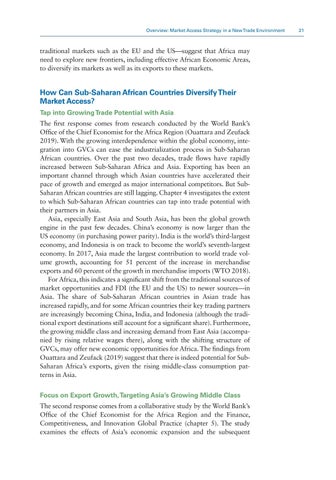Overview: Market Access Strategy in a New Trade Environment 21
traditional markets such as the EU and the US—suggest that Africa may need to explore new frontiers, including effective African Economic Areas, to diversify its markets as well as its exports to these markets.
How Can Sub-Saharan African Countries Diversify Their Market Access? Tap into Growing Trade Potential with Asia The first response comes from research conducted by the World Bank’s Office of the Chief Economist for the Africa Region (Ouattara and Zeufack 2019). With the growing interdependence within the global economy, integration into GVCs can ease the industrialization process in Sub-Saharan African countries. Over the past two decades, trade flows have rapidly increased between Sub-Saharan Africa and Asia. Exporting has been an important channel through which Asian countries have accelerated their pace of growth and emerged as major international competitors. But SubSaharan African countries are still lagging. Chapter 4 investigates the extent to which Sub-Saharan African countries can tap into trade potential with their partners in Asia. Asia, especially East Asia and South Asia, has been the global growth engine in the past few decades. China’s economy is now larger than the US economy (in purchasing power parity). India is the world’s third-largest economy, and Indonesia is on track to become the world’s seventh-largest economy. In 2017, Asia made the largest contribution to world trade volume growth, accounting for 51 percent of the increase in merchandise exports and 60 percent of the growth in merchandise imports (WTO 2018). For Africa, this indicates a significant shift from the traditional sources of market opportunities and FDI (the EU and the US) to newer sources—in Asia. The share of Sub-Saharan African countries in Asian trade has increased rapidly, and for some African countries their key trading partners are increasingly becoming China, India, and Indonesia (although the traditional export destinations still account for a significant share). Furthermore, the growing middle class and increasing demand from East Asia (accompanied by rising relative wages there), along with the shifting structure of GVCs, may offer new economic opportunities for Africa. The findings from Ouattara and Zeufack (2019) suggest that there is indeed potential for SubSaharan Africa’s exports, given the rising middle-class consumption patterns in Asia. Focus on Export Growth, Targeting Asia’s Growing Middle Class The second response comes from a collaborative study by the World Bank’s Office of the Chief Economist for the Africa Region and the Finance, Competitiveness, and Innovation Global Practice (chapter 5). The study examines the effects of Asia’s economic expansion and the subsequent


